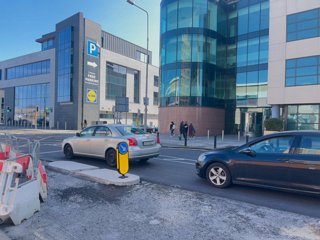ABOUT THE EAST WALL ROAD
The East Wall of today is a place of contrasts. Its historical character as a gritty port district remains evident. Yet, the area is undeniably evolving, with modern development, technological focus, and a changing population altering its landscape. The challenges of gentrification, maintaining community spirit, and balancing the old with the new are ongoing themes as East Wall writes its next chapter.
It should be mentioned that the East Wall cycle lanes are part of a much larger vision for cross-city and cross-country cycling infrastructure in Ireland.
Dublin Bay Cycle Route: The development of cycle lanes along the East Wall is part of the ambitious plan for a continuous cycling path around Dublin Bay. This route aims to connect suburbs all along the coast, from Sandycove in the south to Sutton & Howth in the north.
Canal Connections: Dublin has two major canals, the Grand Canal and the Royal Canal. These waterways are already lined with cycle paths in many parts, offering scenic and car-free routes across the city. Further development aims to connect these paths with the coastal Dublin Bay route, creating an extensive network.
The Dublin to Belfast Link: The ultimate goal is to create seamless cycleways linking Dublin to Belfast. This plan involves utilising existing towpaths along rivers and canals, as well as developing new sections to bridge gaps.
Benefits:
Sustainable Transportation: Encouraging cycling creates a healthier, more environmentally friendly way for people to move around the city and further afield.
Recreation and Leisure: Integrated cycle paths provide opportunities for recreation, leisure, and scenic routes.
Tourism Potential: The Dublin-Belfast cycle route has the potential to be an amazing tourist draw, encouraging eco-friendly travel between the two cities.
It should be mentioned that the East Wall cycle lanes are part of a much larger vision for cross-city and cross-country cycling infrastructure in Ireland.
Dublin Bay Cycle Route: The development of cycle lanes along the East Wall is part of the ambitious plan for a continuous cycling path around Dublin Bay. This route aims to connect suburbs all along the coast, from Sandycove in the south to Sutton & Howth in the north.
Canal Connections: Dublin has two major canals, the Grand Canal and the Royal Canal. These waterways are already lined with cycle paths in many parts, offering scenic and car-free routes across the city. Further development aims to connect these paths with the coastal Dublin Bay route, creating an extensive network.
The Dublin to Belfast Link: The ultimate goal is to create seamless cycleways linking Dublin to Belfast. This plan involves utilising existing towpaths along rivers and canals, as well as developing new sections to bridge gaps.
Benefits:
Sustainable Transportation: Encouraging cycling creates a healthier, more environmentally friendly way for people to move around the city and further afield.
Recreation and Leisure: Integrated cycle paths provide opportunities for recreation, leisure, and scenic routes.
Tourism Potential: The Dublin-Belfast cycle route has the potential to be an amazing tourist draw, encouraging eco-friendly travel between the two cities.

ABOUT THE EAST WALL ROAD